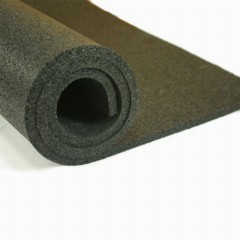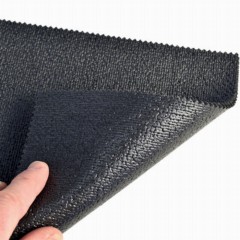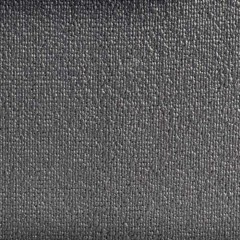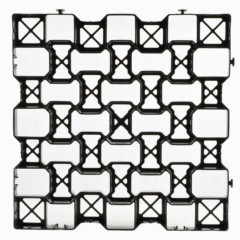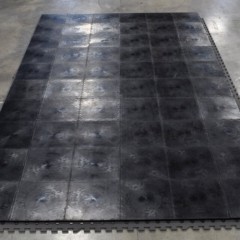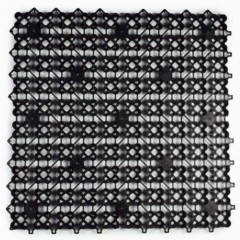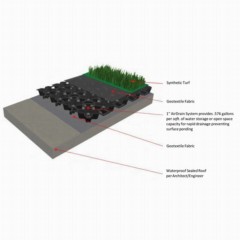Although some floor types work well going directly over the subfloor, other floors require underlayments to provide additional stability as a buffer layer. For durability and excellent performance, count on plastic underlayment options from Greatmats.
We offer both interlocking tiles and rolls that will deliver the stability required to place another type of flooring over top. This is ideal when going over concrete that can seep and allow moisture to penetrate, such as in a basement.
Size and Shape Options
Plastic underlayment products are available in either roll or tile formats. Think about the type of thickness in the underlay that you want to use for the flooring installation. Sometimes, an installation requires a thin, flexible material, while other installations need a firm, thicker material.
For
tiles that serve as plastic underlayment, the most common size we offer has dimensions of 1x1 foot and delivers 1 square foot of coverage area. This is an easy size to handle when doing the installation.
We also offer
perforated tiles that allow for drainage. The use of polyethylene or polypropylene plastic in these tiles is ideal for use outdoors, as they can stand up to all kinds of weather.
Thin rolls work well for dance studios or theaters, creating a safer space for laying out a sheet of vinyl marley flooring or laminate over the top.
Those who need cushioning in the plastic underlayment may want a roll that measures up to 1 inch in thickness. We also offer extremely thin rolls of about 1/16 inch in thickness.
Material Options
Underlay floors are available in a few different plastic materials.
The firmest plastic underlayment options often consist of polypropylene plastic. This is a lightweight plastic, but it has a significant level of durability, so it’s ideal for areas where installers need a stable underlay material.
Softer plastic underlayment materials are available as well. They deliver a little bit of cushioning, which works well for placing them underneath a dance floor. Because dance floor rolls often consist of extremely thin vinyl, having a cushion between a firm subfloor and the roll of dance floor is a smart idea.
For this roll of flooring, we typically offer a blend of primarily PVC plastic with a little bit of polyester included. These floors yield some cushion to keep the lower leg joints of the dancers healthier.
Pattern and Texture Options
Typically, pattern, color, and texture options are not all that important for flooring where customers plan to use it as an underlayment. However, because a few of our tiles work as primary flooring, too, you may have a few color options in certain models.
Most of our underlays are available in solid black. This is a common choice for an underlay, as it won’t easily show dirt or staining. A black-colored underlay has a better chance of blending into the subfloor, allowing the main flooring going over it to stand out and show off its textures and colors.
Having said that, a few of our tiles that are usable as an underlay are available in colors other than black, including gray, blue, or red.
Common Use Options
Underlayment flooring options are usable in a variety of situations. Dance studios are frequent users of underlayment rolls, creating a layer of cushioning underneath the layer of the dance floor.
At home, when you want to create a barrier between a concrete subfloor and the main floor you are installing, our plastic tiles serve well as the underlay.
We also offer perforated tiles made for outdoor use. Use these tiles along a walking trail or in a garden to help hold the soil in place and avoid erosion. These also work nicely for a roof patio, simplifying the process of directing rainwater to drain away.
Installation Options
Customers do not need any special equipment to install these underlayments. Novices can often handle the installation without any previous experience with flooring installations.
With the interlocking tiles, line up the tabs on one tile with the loops on the adjacent tile and snap them together. There is no need to use adhesive on the connecting tabs, as they will hold the layout in place adequately.
When installing rolls of underlay, just place them on the subfloor. There’s no need to use glue on the underside of the roll, as the weight of the main floor going over the top should hold the underlayment in place.
Cleaning and Maintenance Requirements
When using these tiles and rolls as an underlay, you should not need to clean the material regularly. The main floor over the top should prevent most dirt and other debris from reaching the underlay.
However, you should clean the underlayment tiles and rolls whenever you disassemble them to place them in storage. By cleaning them before storing them, they will be ready for the next installation.
Use a broom or vacuum cleaner to remove dry debris from the surface of the underlay. For mopping, use a neutral-pH cleaner and warm water to clean the flooring.











